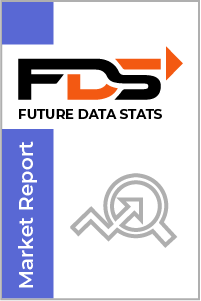The global Autonomous Driving Software Market size was valued at USD 12 Billion in 2024 and is projected to expand at a compound annual growth rate (CAGR) of 25% during the forecast period, reaching a value of USD 75 Billion by 2032.
The "Autonomous Driving Software Market Research Report" by Future Data Stats provides an in-depth examination of the market landscape, utilizing historical data from 2021 to 2023 to identify key trends and growth patterns. Setting 2024 as the foundational year, the report explores consumer behavior, competitive forces, and regulatory frameworks that influence the industry. It transcends basic analysis, delivering a thoroughly researched forecast extending from 2025 to 2033. By employing sophisticated data analysis methodologies, the report not only outlines the market's growth trajectory but also uncovers emerging opportunities and foresees potential obstacles, empowering stakeholders with vital insights to adeptly navigate the changing market landscape.
MARKET OVERVIEW:
Autonomous driving software refers to the suite of technologies and algorithms that enable vehicles to operate with little or no human intervention. This software integrates various components, such as perception, planning, decision-making, and control systems, which collectively allow the vehicle to navigate roads, interpret its environment, and make real-time decisions. The autonomous driving software market is focused on providing solutions that ensure the safety, reliability, and efficiency of self-driving vehicles. For market purposes, the autonomous driving software market encompasses a wide range of software components designed for different levels of automation, from basic driver assistance systems to fully autonomous vehicles. It includes software developed by original equipment manufacturers (OEMs), technology providers, and third-party developers who collaborate to create more advanced systems. As consumer demand for safer, more convenient driving experiences grows, the market for autonomous driving software continues to expand rapidly.
MARKET DYNAMICS:
The latest trends in the autonomous driving software market highlight the increasing integration of artificial intelligence (AI) and machine learning (ML) to enhance vehicle decision-making capabilities. These advancements enable vehicles to process data from various sensors in real time, improving their ability to navigate complex environments. Additionally, the push for higher levels of automation has led to innovations in perception systems, including the use of LiDAR and advanced cameras to provide better object detection and understanding of road conditions. This trend is driving the development of Level 4 and Level 5 autonomous vehicles, where human intervention becomes increasingly minimal. Looking ahead, the autonomous driving software market is expected to experience significant growth due to the rising demand for mobility services, such as autonomous taxis and delivery vehicles. The business scope is broadening as partnerships between technology providers and automakers become more common, aiming to accelerate the deployment of fully autonomous systems. Additionally, advancements in cloud computing and edge computing will play a pivotal role in enabling faster processing of data, further enhancing the performance and safety of autonomous vehicles. These upcoming trends position the market for continued expansion, with new opportunities for businesses to innovate in software development, data management, and vehicle integration.
Companies are investing heavily in research and development to enhance vehicle automation, driven by advancements in artificial intelligence and machine learning. These technologies enable vehicles to navigate complex environments, reducing the likelihood of accidents. Moreover, government initiatives promoting smart transportation systems further stimulate market growth by encouraging innovation and collaboration among industry players. Despite its potential, the autonomous driving software market faces significant challenges. Regulatory hurdles and safety concerns often slow down deployment, as companies must ensure compliance with stringent guidelines. However, these obstacles also present opportunities for innovation. Developers can focus on creating robust safety protocols and user-friendly interfaces to address consumer apprehensions. Additionally, partnerships between tech firms and automotive manufacturers can lead to breakthroughs, fostering a collaborative ecosystem that drives the industry forward.
AUTONOMOUS DRIVING SOFTWARE MARKET SEGMENTATION ANALYSIS
BY TYPE:
Embedded software is the backbone of autonomous driving systems, playing a critical role in managing vehicle hardware. It directly controls essential systems such as sensors, cameras, and motors. As vehicles become increasingly automated, embedded software is designed to handle real-time decision-making tasks with precision, ensuring that the vehicle responds accurately to dynamic driving conditions. This segment has seen a surge in demand due to its necessity for ensuring safety and reliability in self-driving cars. Application software extends the functionality of autonomous vehicles by enabling complex decision-making processes and offering seamless user experiences. It governs navigation, route planning, and traffic interaction, all while integrating with other vehicle systems for optimal performance. The importance of application software continues to grow as vehicles become more autonomous and user-centric. Manufacturers are placing a greater emphasis on creating intuitive software that can adapt to different driving environments and make autonomous driving a reality.
Middleware facilitates smooth communication between the hardware, embedded software, and application software layers. It plays a pivotal role in ensuring that data flows efficiently between the various components of an autonomous vehicle. By acting as an intermediary, middleware enables the integration of diverse technologies, allowing them to work together seamlessly. As the complexity of autonomous systems increases, middleware continues to evolve, providing enhanced interoperability and supporting the expansion of autonomous vehicle fleets.
BY LEVEL OF AUTOMATION:
Level 1 automation, also known as driver assistance, provides basic features like adaptive cruise control and lane-keeping assistance. These systems require the driver to remain engaged and ready to take control at any time. The widespread adoption of these systems is due to the balance they offer between safety improvements and minimal intervention, making them appealing for mainstream consumer markets. As automakers develop more advanced systems, Level 1 technologies continue to serve as a foundation for future innovations in autonomous driving. Level 2 automation, or partial automation, is characterized by the vehicle's ability to control both steering and acceleration simultaneously. However, drivers must still monitor the environment and intervene when necessary. This level has seen significant growth, particularly in premium and mid-range vehicles, as it offers a taste of autonomy without completely removing the driver from the equation. The increasing integration of Level 2 features reflects consumers’ growing trust in semi-autonomous technologies and their desire for more advanced safety features.
Level 3, conditional automation, goes a step further by enabling the vehicle to handle most driving tasks within certain environments. The vehicle can take control, but a driver must remain available to take over if the system encounters an unexpected situation. This level of automation is gaining attention as automakers and regulators test its feasibility for public roads. Although regulatory hurdles and safety concerns remain, the promise of Level 3 technology is driving innovation and pushing the limits of what autonomous vehicles can achieve.
BY VEHICLE TYPE:
Passenger cars are at the forefront of autonomous driving adoption. Automakers are incorporating autonomous software into vehicles ranging from economy models to luxury cars. These vehicles are often the first to introduce driver assistance features and more advanced automation. As the demand for safer, more convenient driving experiences rises, passenger cars are increasingly equipped with sophisticated autonomous systems to meet consumer expectations for both performance and safety. Commercial vehicles, including delivery trucks, buses, and shuttles, represent a significant portion of the autonomous vehicle market. The push for efficiency in logistics and transportation is driving the adoption of autonomous technologies in these vehicles. By automating long-distance and urban transport, commercial vehicles can operate more efficiently, reduce human error, and cut operational costs. As such, fleet owners and logistics companies are among the key drivers of innovation in this space, with autonomous software offering solutions for everything from route optimization to real-time monitoring.
The need for autonomous solutions in both passenger and commercial vehicles highlights the versatility and applicability of autonomous driving technologies across various vehicle types. As vehicles evolve, both sectors are increasingly reliant on advanced software that can provide scalability, adaptability, and the ability to handle complex driving scenarios. With these technologies, autonomous software is expected to continue to grow across various vehicle categories as the industry moves toward full automation.
BY COMPONENT:
Perception software is a cornerstone of autonomous driving systems, enabling vehicles to understand and interpret their surroundings. This software processes data from sensors like cameras, radar, and LiDAR, allowing the vehicle to detect pedestrians, other vehicles, traffic signs, and obstacles. The accuracy and reliability of perception software are essential for the safe operation of autonomous vehicles, and as sensor technologies improve, this software is evolving to provide more precise and faster data processing capabilities. Mapping software provides the high-definition maps required for autonomous vehicles to navigate with precision. These maps offer critical details, such as lane markings, road curves, and intersections, helping vehicles make accurate decisions. As the need for up-to-date and detailed maps grows, so does the demand for sophisticated mapping software that can incorporate real-time updates from the vehicle's sensors. This ensures that autonomous vehicles can maintain their location even in challenging driving environments.
Control software takes the decisions made by the perception and planning systems and translates them into real-world actions, such as steering, braking, and acceleration. It is responsible for ensuring that the vehicle responds smoothly and safely to its environment. The complexity of control software increases as autonomous systems must react to dynamic and sometimes unpredictable scenarios, making it a crucial element for achieving higher levels of automation and ensuring safe vehicle operation under all conditions.
BY DEPLOYMENT MODE:
Cloud-based deployment offers significant advantages for autonomous driving software, particularly in terms of scalability and data processing. The cloud enables centralized storage and real-time updates, ensuring that vehicles are always running the most current software and map data. This deployment model supports large fleets, allowing for seamless over-the-air updates and continuous improvement of autonomous systems. As vehicle connectivity and data sharing become more prevalent, the cloud offers a flexible and cost-effective way to manage and optimize autonomous driving software. On-premise deployment focuses on localizing software and data processing within the vehicle itself. This model reduces dependency on external servers and enhances performance, particularly in scenarios where latency is critical. On-premise systems ensure that vehicles can continue functioning even if they lose connectivity with external networks, offering greater reliability for highly autonomous vehicles operating in remote areas. This approach also provides higher levels of data security, which is essential for the safety and privacy of vehicle occupants.
The combination of cloud-based and on-premise deployment models allows manufacturers to balance real-time, remote data processing with localized, on-vehicle operations. As the autonomous driving ecosystem continues to evolve, hybrid deployment models may emerge, offering the best of both worlds. This flexibility ensures that autonomous systems can adapt to a wide range of environments, from urban areas to rural locations, while maintaining peak performance.
BY END-USER:
Automotive OEMs are the primary players in the autonomous driving software market. These original equipment manufacturers are responsible for integrating autonomous technologies into their vehicles, and their decisions shape the future of the industry. OEMs work closely with software developers and technology providers to create systems that are both safe and reliable. As consumers demand more advanced driving features, OEMs are increasingly investing in autonomous systems to stay competitive and meet regulatory standards. Technology providers play a vital role in developing the software, algorithms, and hardware necessary for autonomous vehicles. These companies specialize in the design and implementation of artificial intelligence, machine learning, and sensor fusion technologies that power autonomous driving systems. By collaborating with OEMs and mobility service providers, technology providers are pushing the boundaries of what is possible in autonomous driving, ensuring continuous advancements and innovations in the field.
Mobility service providers, including companies that offer ride-hailing and autonomous shuttle services, are adopting autonomous driving technology to enhance their operations. These companies benefit from the cost reductions and efficiency improvements that autonomous vehicles can offer. As they move toward fully autonomous fleets, mobility service providers are transforming how people and goods are transported, with a focus on safety, reliability, and reducing human intervention. This sector is expected to play a key role in the widespread deployment of autonomous driving technologies.
REGIONAL ANALYSIS:
North America is witnessing rapid growth, driven by significant advancements in automotive technology and strong demand for autonomous vehicles. Major automakers and technology providers in the U.S. are investing heavily in AI-driven autonomous systems, making the region a leader in the development and deployment of self-driving vehicles. Additionally, favorable government regulations and increased consumer interest in safety and convenience features are accelerating the adoption of autonomous driving software. North America’s robust infrastructure and high level of technological expertise contribute to its position as a dominant market for autonomous driving innovations.
In Europe, the market is expanding as a result of stringent safety regulations and a high level of environmental awareness. European countries like Germany, France, and the UK are at the forefront of autonomous driving development, with many leading automotive companies focusing on both electric and autonomous vehicle solutions. The region is also seeing significant collaboration between automakers and tech firms to enhance the capabilities of autonomous systems. Meanwhile, Asia Pacific is emerging as a fast-growing market, particularly in China and Japan, where there is strong government support for autonomous vehicle research and development. The growing demand for autonomous driving software in these regions is fueled by the rapid adoption of smart city technologies and innovations in electric vehicle infrastructure. Latin America, the Middle East, and Africa show increasing interest in autonomous driving technologies, although these regions face challenges such as infrastructure readiness and regulatory uncertainty. However, as these areas improve their automotive infrastructure and invest in smart city projects, the market for autonomous driving software is expected to grow steadily.
MERGERS & ACQUISITIONS:
- In Jan 2024: Mobileye partnered with a major OEM to integrate its autonomous driving software into next-gen EVs.
- In Feb 2024: Aurora Innovation acquired a lidar startup to enhance its self-driving truck software capabilities.
- In Mar 2024: Waymo expanded its autonomous ride-hailing service to three new U.S. cities.
- In Apr 2024: Tesla released a major FSD (Full Self-Driving) software update with improved urban driving features.
- In May 2024: Cruise resumed limited autonomous vehicle testing in select cities after safety reviews.
- In Jun 2024: Nvidia partnered with a Chinese automaker to deploy its Drive Thor autonomous software platform.
- In Jul 2024: Zoox (Amazon subsidiary) began testing autonomous robotaxis in a new metropolitan area.
- In Aug 2024: Ford’s BlueCruise software expanded to Europe, marking its first international deployment.
- In Sep 2024: BMW and Qualcomm collaborated to develop next-gen autonomous driving software for 2025 models.
- In Oct 2024: Motional (Hyundai & Aptiv JV) secured a new funding round to accelerate driverless tech development.
- In Nov 2024: Huawei launched its latest autonomous driving software for Chinese EV manufacturers.
- In Dec 2024: Toyota acquired an AI software startup to strengthen its autonomous vehicle algorithms.
KEY MARKET PLAYERS:
- Waymo
- Cruise
- Tesla
- Mobileye
- Aurora Innovation
- Zoox
- Nvidia (Drive)
- Motional
- Argo AI
- Baidu Apollo
- Huawei
- ai
- WeRide
- TuSimple
- AutoX
- Momenta
- Oxbotica
- May Mobility
- Embark Trucks
- ai
Autonomous Driving Software Market: Table of Contents
Executive Summary
Market Introduction
- Market Dynamics
- Market Drivers
- Market Restraints
- Market Opportunities
- Market Trends
Impact of COVID-19 on Market
Value Chain Analysis
Technology Overview
Patent Analysis
Regulatory Landscape
Porter’s Five Forces Analysis
Market Segmentation
- By Type
- By Level of Automation
- By Vehicle Type
- By Component
- By Deployment Mode
- By End-User
Competitive Landscape
Company Profiles
Strategic Developments
Conclusion and Analyst Recommendations
Appendix
Glossary of Terms
Autonomous Driving Software Market Segmentation
By Type:
- Embedded Software
- Application Software
- Middleware
By Level of Automation:
- Level 1 (Driver Assistance)
- Level 2 (Partial Automation)
- Level 3 (Conditional Automation)
- Level 4 (High Automation)
- Level 5 (Full Automation)
By Vehicle Type:
- Passenger Cars
- Commercial Vehicles
By Component:
- Perception Software
- Mapping Software
- Control Software
- Localization Software
- Planning and Decision-Making Software
By Deployment Mode:
- Cloud-Based
- On-Premise
By End-User:
- Automotive OEMs
- Technology Providers
- Mobility Service Providers
By Geography:
- North America (USA, Canada, Mexico)
- Europe (UK, Germany, France, Italy, Spain, Rest of Europe)
- Asia-Pacific (China, Japan, Australia, South Korea, India, Rest of Asia-Pacific)
- South America (Brazil, Argentina, Rest of South America)
- Middle East and Africa (GCC Countries, South Africa, Rest of MEA)
WHY SHOULD YOU INVEST IN A MARKET RESEARCH REPORT?
Smarter Business Decisions:
A high-quality market research report delivers valuable insights into industry trends, customer preferences, and competitor strategies. With solid data guiding your choices, you can minimize risks and confidently pursue new opportunities—whether launching a product or expanding into new markets.
Spot Hidden Opportunities:
Market research uncovers unmet customer needs and emerging trends before they become mainstream. By aligning your products or services with these opportunities, you can stay ahead of the competition and capture untapped demand.
Know Your Competition Inside Out:
Gain a clear picture of your competitors' strengths, weaknesses, and strategies. This knowledge helps you refine your unique selling points, craft stronger positioning, and outmaneuver rivals effectively.
Sharper, More Effective Marketing:
Understanding your audience is key to successful marketing. Market research reveals who your customers are, what drives their decisions, and how they engage with brands. With these insights, you can create tailored campaigns that deliver better results and higher ROI.
Reduce Risks Before They Arise:
Every business move carries some risk—but research helps you anticipate challenges before they become costly. By analyzing market conditions and potential obstacles, you can make proactive adjustments to protect your bottom line and reputation.
Strengthen Your Case for Funding:
Investors and lenders want proof of market potential before backing a business. A well-researched report provides the data-driven evidence they need, boosting your credibility and increasing your chances of securing capital.
Stay Ahead of Industry Shifts:
Markets evolve fast, with new technologies, regulations, and consumer behaviors constantly reshaping the landscape. Regular market research ensures you stay informed, adapt quickly, and maintain a competitive edge in your industry.
RESEARCH METHODOLOGY AT FUTURE DATA STATS
At Future Data Stats, we combine decades of industry expertise with cutting-edge research techniques to deliver unparalleled market intelligence. Our team of seasoned analysts employs a dynamic, data-driven approach to uncover actionable insights, helping businesses navigate complex market landscapes with confidence.
Comprehensive & Cutting-Edge Market Analysis
We go beyond surface-level trends to provide a 360-degree view of market dynamics. Our research methodology is designed to:
✔ Accurately assess market size, growth patterns, and competitive landscapes.
✔ Identify emerging opportunities through real-time trend analysis and predictive modeling.
✔ Validate findings with high-quality data, expert consultations, and independent verification.
Our insights empower decision-makers with strategic clarity, ensuring they stay ahead in rapidly evolving industries.
Multi-Source Data Collection & Validation
We leverage a diverse mix of primary and secondary research sources, including:
- In-depth stakeholder interviews (industry leaders, suppliers, distributors, and end-users)
- Statistical databases & market reports from authoritative global sources
- Regional market intelligence to capture localized trends and demand shifts
- Proprietary analytical models tailored to specific industry needs
- By cross-verifying data from multiple streams, we ensure maximum accuracy and reliability.
Key Advantages of Our Research Approach
- Actionable Intelligence – Clear, data-backed recommendations for strategic planning.
- Technology-Enhanced Accuracy – Advanced tools for data validation and trend forecasting.
- Unbiased Insights – Independent analysis free from external influence.
Our Two-Tier Research Framework
- Primary Research – Direct Industry Engagement
- Expert Interviews: Over 25+ hours of discussions with key stakeholders across the value chain.
- Targeted Surveys: Structured questionnaires for KOLs (Key Opinion Leaders) to gauge market sentiment.
- Competitive Benchmarking: Assessing leading players to determine market positioning.
- Secondary Research – Extensive Data Synthesis
- Analysis of 3,000+ documents, including industry reports, whitepapers, and regulatory publications.
- Global & regional data mining from government databases, trade journals, and financial reports.
- Macroeconomic & sector-specific trend mapping for long-term forecasting.
Dual Analytical Approach
We employ both top-down and bottom-up methodologies to ensure precision:
- Bottom-Up Analysis: Calculating market size from granular data, ensuring detailed accuracy.
- Top-Down Assessment: Validating findings through macroeconomic indicators and industry benchmarks.
Why Choose Future Data Stats?
✔ 70+ years of collective expertise in market intelligence.
✔ Customized research models for sector-specific accuracy.
✔ Transparent, reliable, and forward-thinking insights.
With Future Data Stats, you don’t just get data—you get a strategic advantage. Partner with us to unlock the full potential of your market decisions.
Autonomous Driving Software Market Dynamic Factors
Drivers:
- Automakers increase investments in autonomous technology.
- Demand grows for safer, driver-assist features.
- Governments support self-driving pilot projects.
- AI and sensor technologies improve performance.
Restraints:
- High development costs limit widespread deployment.
- Regulatory uncertainty slows real-world testing.
- Public concerns about safety reduce trust.
- Limited infrastructure hampers adoption.
Opportunities:
- Urban mobility services create new software needs.
- Partnerships between tech firms and OEMs accelerate innovation.
- Cloud platforms enable scalable, real-time updates.
- Expansion into emerging markets opens fresh demand
Challenges:
- Navigating diverse traffic laws across regions proves complex.
- Ensuring cybersecurity in connected systems remains critical.
- Scaling from test environments to public roads poses risk.
- Sensor limitations in adverse weather hinder performance.
Autonomous Driving Software Market Regional Key Trends Analysis
North America:
- Tech companies lead real-world autonomous trials.
- Startups receive strong venture capital backing.
- Regulatory testing zones expand in multiple states.
Europe:
- EU supports cross-border autonomous testing.
- Luxury carmakers integrate advanced autonomy levels.
- Data protection laws influence software development.
Asia-Pacific:
- China accelerates smart city and AV integration.
- Japan prioritizes self-driving for aging population.
- South Korea backs domestic AV software R&D.
Latin America:
- Governments explore AV use in public transport.
- Infrastructure gaps slow broad deployment.
- Early adoption focuses on fleet and logistics.
Middle East & Africa:
- Smart city projects include autonomous mobility.
- Government-led pilots test AVs in controlled zones.
- Investments target high-tech tourism transport.
Frequently Asked Questions

















